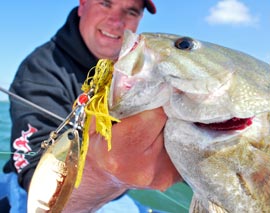Best Cast Wins

A pattern develops where a certain angle to the cover from the boat accounts for most of the fish and that can be attributed to how the fish are positioned in the shade or on the cover in what direction most of the fish are facing.
There are exceptions where anglers are targeting bass over large flats, deep weed bed edges or open water. Most of the time, however on so many bodies of water where we are finding a shallow bite, most fish are coming off of a visible cover and the hit is within two cranks of the reel handle.
Whenever we are targeting bass on docks, timber or shallow slope, the strike occurs almost immediately after the lure touches the water. When targeting fish that are tucked up along shallow shoreline cover, the best caster wins.
 Finding the Right Lure
Finding the Right Lure
So often, anglers get consumed with finding the right lure, the right color, the right profile and while dialing in the presentation can be so important, the right cast often gets overlooked.
Where the lure hits the water in relation to the cover and how the lure hits the water is often what separates great anglers from average anglers.
So often, you don’t get a second chance to make a first impression so following up a bad cast or bad lure placement with a good cast often isn’t good enough if the first cast turned the fish or spooked the fish.
Each fish is different and how fish respond to a cast can change dramatically as the sun pops out but sewing a bait into heavy cover without banging or clanking a dock or piece of wood takes practice.
Avoid hitting Docks
A good friend of mine, Eric Naig used to work for Pure Fishing for several years and now resides in Bemidji, Minnesota as one of the chief lure designers for Northland Fishing Tackle and Impulse soft plastic baits.
According to Naig, hitting docks and other cover can sometimes create noise that will actually turn fish towards the lure as it hits the water but most days, noise can really spook fish.
The initial splash or touchdown of the bait is often the primary trigger that causes a bass to turn and accelerate towards the lure. Too hard of a touch down might be a negative some days where there are other situations where a hard splash brings fish over from further away.
Experimenting with how hard the lure makes contact with the water is a variable to experiment just like switching retrieve speeds or colors. Naig stresses that this contact point where lure hits water is something to play with.
Targeting the Splash
Often, just the lure entering the water with a subtle plop or splash is enough to trigger fish, especially fish that are within a few feet. When you are accurately casting and hitting your targets, less is often more.
To soften the impact, an angler just has to cast the lure or bait at a low trajectory and feather the spool of the bait casting reel with the thumb to dampen the impact. Too much dampening however can cause the lure or bait to shoot forward as it hits the water. Over some types of terrain this is alright but when fishing docks, lily pads and shallow timber where bass are often positioned at the bottom of the cover, many anglers pop the rod tip back as the lure hits the water to create enough line by free spooling the reel so that the lure or bait can drop straight down.
So often with bass fishing, anglers have the mindset to pound the area with casts but fewer well placed casts often catch more fish than many random casts that miss the mark. Bad casts can turn the fish to where they are positioned on the cover in an unpredictable position. Slow the day down and focus on hitting each piece of cover with precision. Focus on making the first cast on that cover the best cast and work on the angle the lure makes getting to and from that cover.
You have to not only get the lure close to the fish but also in front of the fish for the best batting average. By far, on many fisheries across the Country, you can catch a lot more fish by practicing and focusing on casting.
Practicing Your Cast
Casting in the back yard is not as glamorous as researching how to use a new piece of sonar equipment and doesn’t generate sales like the best new 7 inch worm to come out this century but if you are serious about catching more bass, remember that the first and best cast on a spot often catches the most fish.
As an angler, if you focus on these basic fundamentals and are conscience of not only how important the right cast is but how damaging the wrong cast is you can increase the amount of fish you catch this season.
About Jason Mitchell
Jason Mitchell hosts the popular outdoor program Jason Mitchell Outdoors which airs across the Midwest on Fox Sports North and Fox Sports Midwest. Before television Mitchell earned a reputation as a top hunting and fishing guide on Devils Lake, North Dakota where he spent over two hundred and fifty days each season on the water and ice for over a decade. Mitchell shares his insights and tactics learned from an extensive amount of time on the water in each article.
More tips from Jason can be found in these articles:



